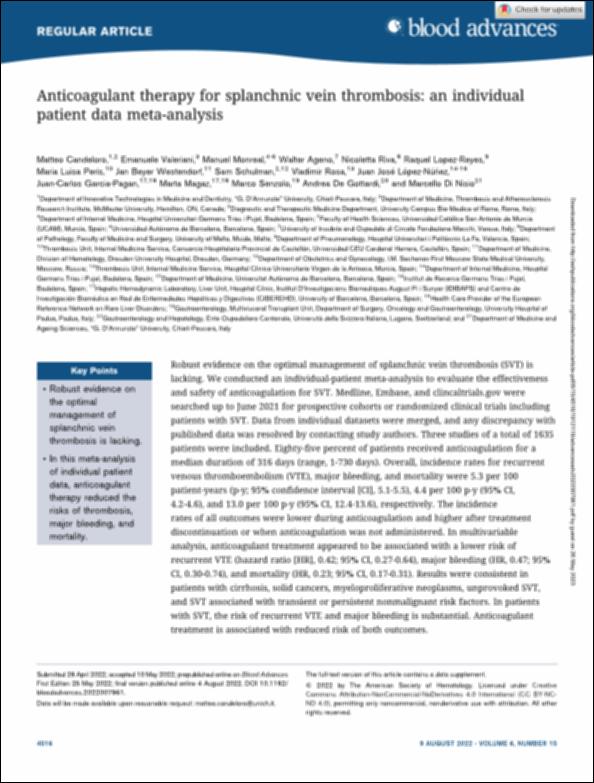Please use this identifier to cite or link to this item:
http://hdl.handle.net/10637/14364Anticoagulant therapy for splanchnic vein thrombosis an individual patient data meta-analysis
| Title: | Anticoagulant therapy for splanchnic vein thrombosis an individual patient data meta-analysis |
| Authors : | Candeloro, Matteo Valeriani, Emanuele Monreal Bosch, Manuel Ageno, Walter Riva, Nicoletta López Reyes, Raquel Peris Sifre, María Luisa |
| Keywords: | Thrombosis - Treatment.; Hemostasia.; Blood - Coagulation - Treatment.; Sangre - Coagulación - Tratamiento.; Trombosis - Tratamiento.; Hemostasis. |
| Publisher: | American Society of Hematology |
| Citation: | Candeloro, M., Valeriani, E., Monreal, M., Ageno, W., Riva, N., Lopez-Reyes, R., Peris, M. L., Beyer Westendorf, J., Schulman, S., Rosa, V., López-Núñez, J. J., Garcia-Pagan, J. C., Magaz, M., Senzolo, M., De Gottardi, A. & Di Nisio, M. (2022). Anticoagulant therapy for splanchnic vein thrombosis: an individual patient data meta-analysis. Blood Advances, vol. 6, i. 15 (04 aug.), pp. 4516–4523. DOI: https://doi.org/10.1182/bloodadvances.2022007961 |
| Abstract: | Robust evidence on the optimal management of splanchnic vein thrombosis (SVT) is lacking. We conducted an individual-patient meta-analysis to evaluate the effectiveness and safety of anticoagulation for SVT. Medline, Embase, and clincaltrials.gov were searched up to June 2021 for prospective cohorts or randomized clinical trials including patients with SVT. Data from individual datasets were merged, and any discrepancy with published data was resolved by contacting study authors. Three studies of a total of 1635 patients were included. Eighty-five percent of patients received anticoagulation for a median duration of 316 days (range, 1-730 days). Overall, incidence rates for recurrent venous thromboembolism (VTE), major bleeding, and mortality were 5.3 per 100 patient-years (p-y; 95% confidence interval [CI], 5.1-5.5), 4.4 per 100 p-y (95% CI, 4.2-4.6), and 13.0 per 100 p-y (95% CI, 12.4-13.6), respectively. The incidence rates of all outcomes were lower during anticoagulation and higher after treatment discontinuation or when anticoagulation was not administered. In multivariable analysis, anticoagulant treatment appeared to be associated with a lower risk of recurrent VTE (hazard ratio [HR], 0.42; 95% CI, 0.27-0.64), major bleeding (HR, 0.47; 95% CI, 0.30-0.74), and mortality (HR, 0.23; 95% CI, 0.17-0.31). Results were consistent in patients with cirrhosis, solid cancers, myeloproliferative neoplasms, unprovoked SVT, and SVT associated with transient or persistent nonmalignant risk factors. In patients with SVT, the risk of recurrent VTE and major bleeding is substantial. Anticoagulant treatment is associated with reduced risk of both outcomes. |
| Description: | Este artículo se encuentra disponible en la siguiente URL: https://ashpublications.org/bloodadvances/article/6/15/4516/485361/Anticoagulant-therapy-for-splanchnic-vein En este artículo de investigación también participan: Jan Beyer Westendorf, Sam Schulman, Vladimir Rosa, Juan José López-Núñez, Juan-Carlos Garcia-Pagan, Marta Magaz, Marco Senzolo, Andrea De Gottardi y Marcello Di Nisio. |
| URI: | http://hdl.handle.net/10637/14364 |
| Rights : | http://creativecommons.org/licenses/by-nc-nd/4.0/deed.es |
| ISSN: | 2473-9529 (Electrónico) |
| Language: | es |
| Issue Date: | 4-Aug-2022 |
| Center : | Universidad Cardenal Herrera-CEU |
| Appears in Collections: | Dpto. Medicina y Cirugía |
Items in DSpace are protected by copyright, with all rights reserved, unless otherwise indicated.


